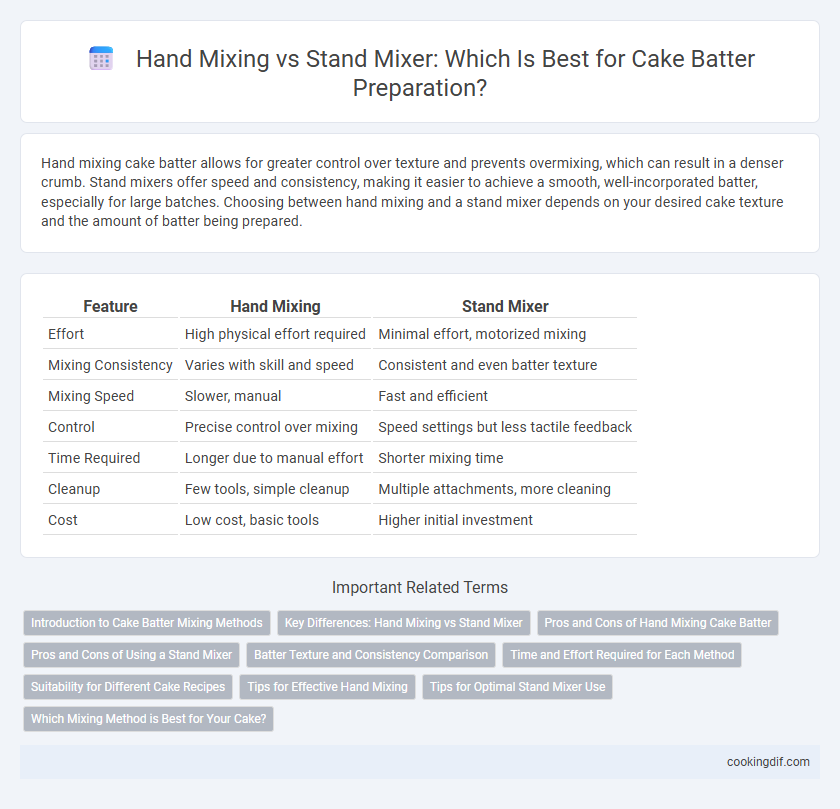Hand mixing cake batter allows for greater control over texture and prevents overmixing, which can result in a denser crumb. Stand mixers offer speed and consistency, making it easier to achieve a smooth, well-incorporated batter, especially for large batches. Choosing between hand mixing and a stand mixer depends on your desired cake texture and the amount of batter being prepared.
Table of Comparison
| Feature | Hand Mixing | Stand Mixer |
|---|---|---|
| Effort | High physical effort required | Minimal effort, motorized mixing |
| Mixing Consistency | Varies with skill and speed | Consistent and even batter texture |
| Mixing Speed | Slower, manual | Fast and efficient |
| Control | Precise control over mixing | Speed settings but less tactile feedback |
| Time Required | Longer due to manual effort | Shorter mixing time |
| Cleanup | Few tools, simple cleanup | Multiple attachments, more cleaning |
| Cost | Low cost, basic tools | Higher initial investment |
Introduction to Cake Batter Mixing Methods
Hand mixing cake batter allows for greater control over texture and aeration, ideal for delicate recipes requiring gentle incorporation of ingredients. Stand mixers provide consistent speed and power, ensuring thorough mixing and efficient incorporation of butter, sugar, and eggs for dense or large-batch cakes. Understanding these methods enhances cake quality by matching mixing techniques to batter type and desired crumb structure.
Key Differences: Hand Mixing vs Stand Mixer
Hand mixing cake batter offers greater control over texture and consistency, allowing for gentle incorporation of ingredients to avoid overmixing. Stand mixers provide consistent, efficient mixing with multiple speed settings, ideal for thicker batters and large quantities. Key differences include mixing power, time efficiency, and risk of over-aeration affecting cake crumb structure.
Pros and Cons of Hand Mixing Cake Batter
Hand mixing cake batter offers precise control over mixing speed and texture, preventing overmixing and resulting in a tender crumb. It requires minimal equipment and is easy to clean, making it ideal for small batches or delicate recipes. However, hand mixing is more time-consuming and physically demanding, which may lead to inconsistent results compared to the efficiency of a stand mixer.
Pros and Cons of Using a Stand Mixer
A stand mixer offers consistent speed control and powerful mixing, making it ideal for achieving smooth and well-incorporated cake batter quickly, which enhances texture and rise. However, its size and weight make it less portable and harder to clean compared to hand mixing, and overmixing risks gluten development leading to denser cakes. Stand mixers also allow hands-free operation, enabling multitasking, but their higher cost and space requirements might be a drawback for occasional bakers.
Batter Texture and Consistency Comparison
Hand mixing creates a batter with a slightly denser texture due to less incorporation of air, resulting in a more controlled and uniform consistency. Stand mixers, equipped with higher-speed settings and powerful motors, aerate the batter more efficiently, producing a lighter, fluffier texture ideal for delicate cakes. The choice between hand mixing and using a stand mixer directly impacts the batter's smoothness and rise potential, influencing the final cake's crumb and moisture retention.
Time and Effort Required for Each Method
Hand mixing cake batter typically demands more physical effort and takes approximately 5 to 10 minutes depending on the recipe complexity, resulting in a slightly uneven texture. Stand mixers significantly reduce preparation time to about 3 to 5 minutes while minimizing labor, providing a consistently smooth batter ideal for delicate cakes. Choosing a stand mixer enhances efficiency, especially for large batches, whereas hand mixing suits small quantities or limited kitchen equipment.
Suitability for Different Cake Recipes
Hand mixing provides precise control over delicate cake batters such as chiffon and sponge, preserving their light texture and preventing overmixing. Stand mixers excel in handling dense or heavy batters like butter cakes and fruit cakes, ensuring thorough blending and consistent results. Selecting the appropriate method improves batter consistency and final cake quality based on recipe requirements.
Tips for Effective Hand Mixing
Hand mixing cake batter requires consistent circular motions and scraping the bowl's sides to incorporate ingredients evenly and avoid overmixing, which can make the cake dense. Use a sturdy spatula or wooden spoon to fold in ingredients gently and maintain the batter's desired texture. Resting the batter briefly before baking helps hydrate the flour and improve the final crumb structure when hand mixing.
Tips for Optimal Stand Mixer Use
For optimal stand mixer use when preparing cake batter, ensure the mixer is fitted with the paddle attachment to achieve even mixing without over-aerating. Start mixing at low speed to combine ingredients gently, then gradually increase speed to medium for thorough blending. Regularly scrape down the bowl sides to incorporate all ingredients evenly and prevent overmixing, which can lead to dense cakes.
Which Mixing Method is Best for Your Cake?
Hand mixing offers greater control over batter texture, helping to avoid overmixing which can lead to dense cakes, while stand mixers provide consistent, efficient blending suitable for large batches or complex recipes. The best mixing method depends on cake type and desired crumb; delicate cakes like chiffon benefit from gentle hand mixing, whereas denser varieties, such as butter cakes, often require the thorough incorporation achieved by a stand mixer. Key factors in deciding include batter volume, recipe specificity, and the importance of aeration, making the choice crucial for optimal cake rise and texture.
Hand Mixing vs Stand Mixer for batter preparation Infographic

 cookingdif.com
cookingdif.com